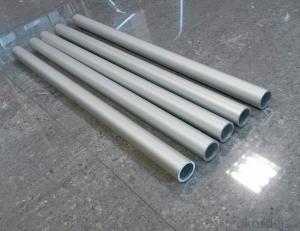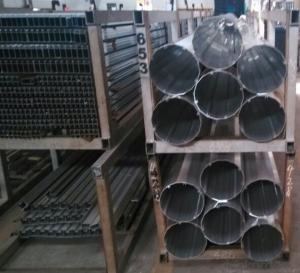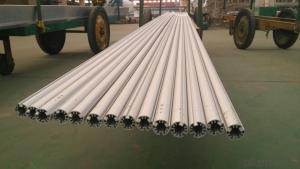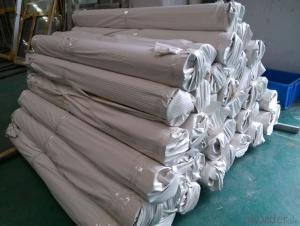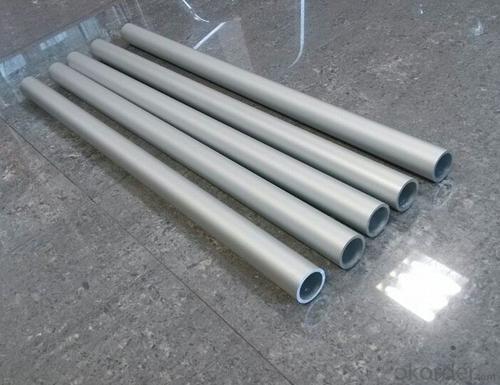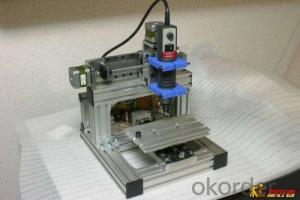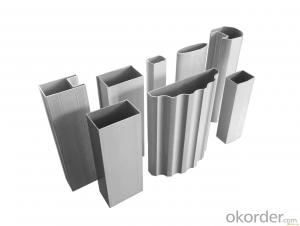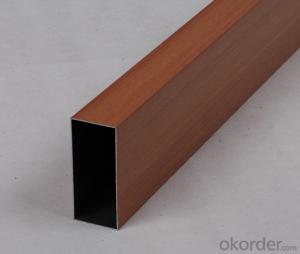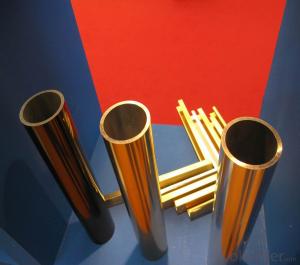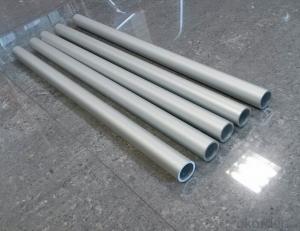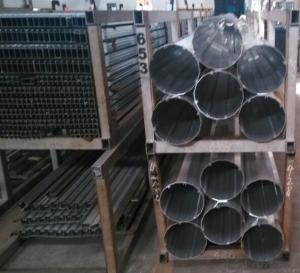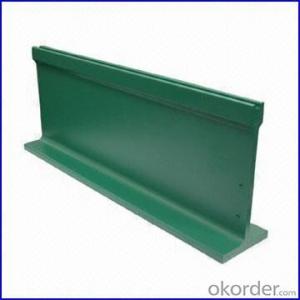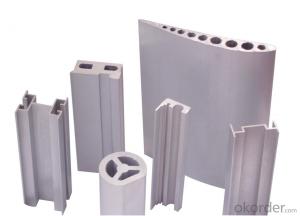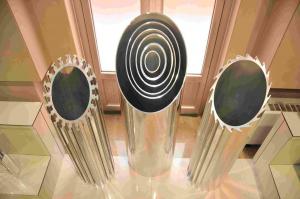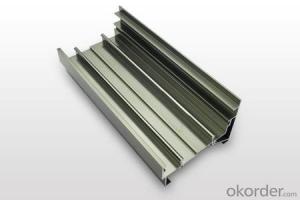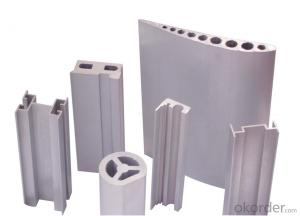Aluminum Extrusion Triangle Profiles for Furniture - Aluminium Round Tubes/Pipes
- Loading Port:
- Shanghai
- Payment Terms:
- TT OR LC
- Min Order Qty:
- 5 m.t.
- Supply Capability:
- 1000 m.t./month
OKorder Service Pledge
OKorder Financial Service
You Might Also Like
Specifications
1) Products: Round pipe, square pipe, flat pipe, special designed pipe
2) Grade: 1050,3003,5052,5083,6005,6061,6063,6082 etc.
3) WT:0.3mm above
4) OD: up to 550mm
5) Length: per customer's request
6) Process: heat extrusion, welding, seamless
Square industrial aluminium tube
1. Tolerance of frame thickness: +/-0.1-0.25mm.
2. Alloy & temper: Grade 6000 Series, T4-T6
3. Thickness: 1.0mm or according to customer’s requirements.
4. Max. Length: 6.0m, export length for 20" Container: 5.8m.
Round industrial aluminium tube
1. Tolerance of frame thickness: +/-0.1~0.25mm.
2. Alloy & temper: 6063-T5, Grade 6000 Series.
3. Thickness: 1.0mm , according to customer’s requirements.
4. Diameter: 2.5mm or according to customer’s requirements.
5. Max. Length:6m, export length for 20" Container: 5.8m.
Alloy | Si | Mg | Fe | Cu | Mn | Zn | Cr | Ti |
1050 | 0.25 | 0.05 | <0.40 | <0.05 | <0.05 | <0.05 | - | <0.03 |
3003 | 0.6 | 0.7 | 0.05 -0.20 | 1.0-1.5 | 0.10 | - | ||
5052 | 0.25 | 2.2-2.8 | 0.4 | 0.1 | 0.1 | 0.10 | 0.15-0.35 | - |
5083 | 0.4 | 4.0-4.9 | 0.4 | 0.1 | 0.4-1.0 | 0.25 | 0.05-0.25 | 0.15 |
6005 | 0.6-0.9 | 0.4-0.6 | <0.35 | <0.1 | <0.1 | <0.1 | <0.1 | <0.1 |
6061 | 0.4-0.8 | 0.8-1.2 | <0.70 | 0.15-0.4 | <0.15 | <0.25 | 0.04-0.35 | <0.05 |
6063 | 0.2-0.6 | 0.45-0.9 | <0.35 | <0.1 | <0.1 | <0.1 | <0.1 | <0.1 |
6082 | 0.7-1.3 | 0.6-1.2 | <0.50 | <0.1 | 0.4-1.0 | <0.2 | <0.25 | <0.10 |
| Alloy | NO | Temper | Out Side diameter(mm) | Thickness (mm) | Length (mm) |
| 1XXX | 1060,1100,1070A,1050A,1035,1200 | O,H112,H14,H18,F | 6-550(Max) | >=0.4 | 10-12000 |
| 2xxx | 2A11,2A12,2014,2024,2007 | O,T4,T42,T6,T62 | 6-550(Max) | >=0.4 | 10-12000 |
| 3xxx | 3003,3A21 | O,H12,H14,H16,H18,F | 6-550(Max) | >=0.4 | 10-12000 |
| 5xxx | ,5052,5083,5154,5450 | O,H32,H34,H36,H38,F | 6-550(Max) | >=0.4 | 10-12000 |
| 6xxx | ,6061,6063,6082 | O,T4,T42,T6,T62,T83,T831 | 6-550(Max) | >=0.4 | 10-12000 |
| 7xxx | 7A04,7A09,7075 | 0,T6,T62,T73 | 6-550(Max) | >=0.4 | 10-12000 |
Surface treatments :
1) Anodizing
2) Polishing
3) Powder coated
4) Electrophoresis
5) Sand-blast
6) Coating film
etc
Applications :
1) Micro-motors
2) Cylinder machines without wearing sleeve
3) Pneumatic cylinder
4) Heat transfer equipment
5) Construction industry
6) Curtain track
7) Structure support
8) Irrigation pipes
9) Furniture
- Q: How do aluminum profiles contribute to sustainable transportation solutions?
- Aluminum profiles play a significant role in promoting sustainable transportation solutions in several ways. Firstly, aluminum is a lightweight material, which means it can significantly reduce the weight of vehicles such as cars, buses, trains, and airplanes. This reduction in weight leads to improved fuel efficiency and lower greenhouse gas emissions. By using aluminum profiles in the manufacturing process, vehicles consume less energy and produce fewer pollutants, making them more environmentally friendly. Secondly, aluminum is a highly recyclable material. It can be easily recycled and reprocessed, allowing for the creation of new aluminum profiles without compromising their quality or performance. This recyclability aspect promotes a circular economy, reducing the need for extracting and refining raw materials continually. It also decreases the amount of waste generated and minimizes the environmental impact associated with the production and disposal of aluminum profiles. Furthermore, aluminum profiles are durable and corrosion-resistant, which extends the lifespan of vehicles. The increased durability reduces the frequency of maintenance and replacements, leading to lower resource consumption and waste generation. Consequently, it contributes to a more sustainable transportation system by reducing the overall environmental impact associated with vehicle manufacturing and operation. Additionally, aluminum profiles can be designed to enhance aerodynamics and improve the overall performance of vehicles. By reducing drag and optimizing airflow, aluminum profiles contribute to increased fuel efficiency and reduced energy consumption. This improved performance not only benefits the environment but also reduces operational costs for transportation companies and individuals. Overall, the use of aluminum profiles in transportation solutions has a positive impact on sustainability. It reduces vehicle weight, promotes recycling, extends lifespan, and enhances performance, all of which contribute to a more eco-friendly and efficient transportation system. By embracing aluminum profiles, the transportation industry can take significant strides towards achieving a more sustainable and greener future.
- Q: How much is the 5000 ton aluminum profile extrusion machine? What section can I have?
- I've been in the aluminum industry for several years and haven't seen 5000 tons
- Q: This question asks if aluminum profiles can be used in outdoor settings and seeks an explanation for their suitability.
- <p>Yes, aluminum profiles can be used for outdoor applications. They are suitable for outdoor use due to their high resistance to corrosion, which is a result of the natural oxide layer that forms on aluminum when exposed to air. This layer protects the aluminum from further oxidation and damage. Additionally, aluminum profiles are lightweight, strong, and can withstand various weather conditions, making them ideal for applications such as outdoor furniture, construction, and signage. Their durability and low maintenance requirements also contribute to their popularity in outdoor settings.</p>
- Q: Can aluminum profiles be used in swimming pool enclosures or structures?
- Yes, aluminum profiles can be used in swimming pool enclosures or structures. Aluminum is a popular choice for constructing swimming pool enclosures due to its excellent corrosion resistance and durability. It is resistant to rust and degradation from exposure to water and chlorine, making it ideal for use in a pool environment. Additionally, aluminum profiles can be easily shaped, welded, and installed, allowing for the construction of custom-designed enclosures that meet specific requirements and aesthetics. They are also lightweight, which makes them easier to handle and transport during installation. Overall, aluminum profiles offer a reliable and long-lasting solution for swimming pool enclosures or structures.
- Q: How do I maintain and clean aluminum profiles?
- To maintain and clean aluminum profiles, there are a few steps you can follow: 1. Regular dusting: Start by removing any loose dust or dirt using a soft cloth or a feather duster. This will prevent the build-up of grime and make the cleaning process easier. 2. Prepare a cleaning solution: Mix a mild detergent or dish soap with warm water in a bucket or a spray bottle. Avoid using harsh chemicals or abrasive cleaners as they can damage the aluminum surface. 3. Wipe down the profiles: Dip a soft cloth or sponge into the cleaning solution and gently scrub the aluminum profiles. Pay special attention to any areas with stains or stubborn dirt. 4. Rinse with clean water: After cleaning, rinse the profiles thoroughly with clean water to remove any residual soap or cleaning solution. This step is crucial to prevent any residue from drying and leaving streaks or marks. 5. Dry the profiles: Use a soft, dry cloth or towel to wipe the aluminum profiles dry. This will help prevent water spots and maintain the shine of the metal. 6. Polish (optional): If desired, you can apply a non-abrasive aluminum polish to further enhance the shine and protect the surface. Follow the instructions on the polish packaging for best results. 7. Regular maintenance: To keep the aluminum profiles in good condition, it is essential to perform regular maintenance. This includes dusting them regularly, avoiding abrasive materials or cleaners, and addressing any stains or spills promptly. By following these steps, you can maintain and clean aluminum profiles effectively, keeping them looking great for longer periods.
- Q: This question asks about the methods to ensure that aluminum profiles used in construction meet safety standards.
- <p>To ensure that aluminum profiles used in building construction meet safety standards, you should follow these steps: 1) Source from reputable suppliers who adhere to industry standards. 2) Check for certifications such as ISO 9001 for quality management. 3) Verify the aluminum's grade and alloy type to ensure it's suitable for construction use. 4) Conduct regular inspections and tests, including tensile strength and load-bearing capacity tests. 5) Adhere to local building codes and regulations. 6) Use profiles with appropriate thickness and dimensions for the intended application. 7) Consult with engineers or architects to ensure proper design and installation. 8) Keep records of all tests and inspections for future reference and compliance checks.</p>
- Q: What are the different types of extrusion processes used for aluminum profiles?
- There are several different types of extrusion processes used for manufacturing aluminum profiles. These processes are commonly used in the aluminum industry to create a wide range of shapes and sizes for various applications. 1. Direct Extrusion: This is the most common type of extrusion process used for aluminum profiles. In this process, a heated aluminum billet is forced through a die using a ram or screw, resulting in a continuous profile with a consistent cross-section. 2. Indirect Extrusion: Also known as backward extrusion, this process involves forcing the heated billet through a stationary die using a hollow ram. The ram pushes against the back of the billet, causing it to flow through the die and form the desired profile. 3. Hydrostatic Extrusion: Hydrostatic extrusion is a specialized process used for extruding aluminum profiles with complex shapes and thin walls. In this process, the billet is placed in a sealed container filled with a pressurized fluid, which helps to control the flow of the material and reduce the risk of defects. 4. Impact Extrusion: This process is used to create hollow profiles by striking a slug of aluminum with a punch while it is inside a die. The impact forces the material to flow around the punch and take the shape of the die, resulting in a seamless profile with excellent dimensional accuracy. 5. Cold Extrusion: Cold extrusion is a process used to manufacture aluminum profiles at room temperature. In this process, a billet is placed in a die and pressure is applied to force the material through the die, resulting in a profile with improved strength and surface finish. 6. Hot Extrusion: Hot extrusion is similar to direct extrusion, but the billet is heated to a higher temperature before being forced through the die. The elevated temperature helps to reduce the material's strength and increase its ductility, allowing for the creation of more complex profiles. Each of these extrusion processes has its advantages and limitations, and the choice of the process depends on factors such as the desired profile shape, size, complexity, and the specific requirements of the application.
- Q: What unique considerations or criteria must be met when installing aluminum profiles in areas with heavy foot traffic?
- <p>When installing aluminum profiles in high-traffic areas, special requirements include selecting profiles with high load-bearing capacity, using durable materials resistant to wear and tear, and ensuring the profiles have slip-resistant surfaces. It's also crucial to consider the ease of maintenance and cleaning, as these areas will require more frequent upkeep. Additionally, profiles should be designed to withstand frequent contact and potential impacts, and they must comply with safety regulations to prevent accidents.</p>
- Q: Explain if aluminum profiles can be utilized in constructing energy-efficient building systems and if so, how they contribute to energy efficiency.
- <p>Yes, aluminum profiles can be used to create energy-efficient building systems. They are lightweight yet strong, which reduces the energy required for construction. Aluminum profiles also have excellent thermal conductivity, allowing them to be used in double-glazed windows and doors, improving insulation and reducing heat loss. Additionally, aluminum can be easily recycled, reducing the energy needed for new materials. Their high reflectivity can also help in reducing heat absorption, further contributing to energy efficiency.</p>
- Q: How do aluminum profiles perform in earthquake-resistant structures?
- Aluminum profiles perform well in earthquake-resistant structures due to their lightweight yet strong properties. They have high strength-to-weight ratio, which helps in reducing the overall weight of the structure while providing sufficient strength to withstand seismic forces. Additionally, aluminum is highly ductile and can absorb a significant amount of energy during an earthquake, thereby reducing the risk of structural failure. Furthermore, aluminum profiles can be easily fabricated and assembled, offering flexibility in design and construction. Overall, aluminum profiles contribute to the resilience and performance of earthquake-resistant structures.
Send your message to us
Aluminum Extrusion Triangle Profiles for Furniture - Aluminium Round Tubes/Pipes
- Loading Port:
- Shanghai
- Payment Terms:
- TT OR LC
- Min Order Qty:
- 5 m.t.
- Supply Capability:
- 1000 m.t./month
OKorder Service Pledge
OKorder Financial Service
Similar products
Hot products
Hot Searches
Related keywords
